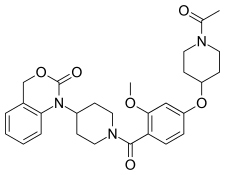L-371,257
L-371,257 is a compound used in scientific research which acts as a selective antagonist of the oxytocin receptor with over 800x selectivity over the related vasopressin receptors.[1] It was one of the first non-peptide oxytocin antagonists developed,[2][3][4][5] and has good oral bioavailability, but poor penetration of the blood–brain barrier, which gives it good peripheral selectivity with few central side effects.[6] Potential applications are likely to be in the treatment of premature labour.[7]
 | |
| Clinical data | |
|---|---|
| Routes of administration | By mouth |
| ATC code |
|
| Identifiers | |
IUPAC name
| |
| CAS Number | |
| PubChem CID | |
| IUPHAR/BPS | |
| ChemSpider | |
| ChEMBL | |
| CompTox Dashboard (EPA) | |
| Chemical and physical data | |
| Formula | C28H33N3O6 |
| Molar mass | 507.577 g/mol g·mol−1 |
| 3D model (JSmol) | |
SMILES
| |
InChI
| |
| | |
References
- Williams PD, Clineschmidt BV, Erb JM, Freidinger RM, Guidotti MT, Lis EV, Pawluczyk JM, Pettibone DJ, et al. (1995). "1-(1-4-(N-acetyl-4-piperidinyl)oxy-2-methoxybenzoylpiperidin-4- yl)-4H-3,1-benzoxazin-2(1H)-one (L-371,257): a new, orally bioavailable, non-peptide oxytocin antagonist". Journal of Medicinal Chemistry. 38 (23): 4634–6. doi:10.1021/jm00023a002. PMID 7473590.
- Bell IM, Erb JM, Freidinger RM, Gallicchio SN, Guare JP, Guidotti MT, Halpin RA, Hobbs DW, et al. (1998). "Development of orally active oxytocin antagonists: studies on 1-(1-4-1-(2-methyl-1-oxidopyridin-3-ylmethyl)piperidin-4-yloxy-2- methoxybenzoylpiperidin-4-yl)-1,4-dihydrobenzd1,3oxazin-2-one (L-372,662) and related pyridines". Journal of Medicinal Chemistry. 41 (12): 2146–63. doi:10.1021/jm9800797. PMID 9622556.
- Kuo MS, Bock MG, Freidinger RM, Guidotti MT, Lis EV, Pawluczyk JM, Perlow DS, Pettibone DJ, et al. (1998). "Nonpeptide oxytocin antagonists: potent, orally bioavailable analogs of L-371,257 containing a 1-R-(pyridyl)ethyl ether terminus". Bioorganic & Medicinal Chemistry Letters. 8 (21): 3081–6. doi:10.1016/S0960-894X(98)00568-X. PMID 9873680.
- Williams PD, Bock MG, Evans BE, Freidinger RM, Gallicchio SN, Guidotti MT, Jacobson MA, Kuo MS, et al. (1999). "Nonpeptide oxytocin antagonists: analogs of L-371,257 with improved potency". Bioorganic & Medicinal Chemistry Letters. 9 (9): 1311–6. doi:10.1016/S0960-894X(99)00181-X. PMID 10340620.
- Wyatt PG, Allen MJ, Chilcott J, Foster A, Livermore DG, Mordaunt JE, Scicinski J, Woollard PM (2002). "Identification of potent and selective oxytocin antagonists. Part 1: indole and benzofuran derivatives". Bioorganic & Medicinal Chemistry Letters. 12 (10): 1399–404. doi:10.1016/S0960-894X(02)00159-2. PMID 11992786.
- Ring RH, Malberg JE, Potestio L, Ping J, Boikess S, Luo B, Schechter LE, Rizzo S, et al. (2006). "Anxiolytic-like activity of oxytocin in male mice: behavioral and autonomic evidence, therapeutic implications". Psychopharmacology. 185 (2): 218–25. doi:10.1007/s00213-005-0293-z. PMID 16418825.
- Hawtin SR, Ha SN, Pettibone DJ, Wheatley M (2005). "A Gly/Ala switch contributes to high affinity binding of benzoxazinone-based non-peptide oxytocin receptor antagonists". FEBS Letters. 579 (2): 349–56. doi:10.1016/j.febslet.2004.10.108. PMID 15642343.
This article is issued from
Wikipedia.
The text is licensed under Creative
Commons - Attribution - Sharealike.
Additional terms may apply for the media files.